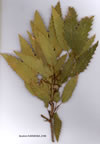| Fagaceae |
 Quercus libani |
| Quercus L. Quercus libani OLIVIER Ömür: Çok yıllık Yapı: çalı veya küçük ağaç Hayat formu: İlk çiçeklenme zamanı: 8 Son çiçeklenme zamanı: 10 Habitat: saf populasyonlar veya diğer Quercus türleri ile karışık Minimum yükseklik: 700 Maksimum yükseklik: 2000 Endemik: - Element: İran-Turan Türkiye dağılımı: D. Anadolu, B.'dan G. Anadolu (Anti-Toroslar)'ya kadar Genel dağılımı: Latakya, Suriye Çöl (?), KB. Irak, B. İran Bulunduğu kareler :-- |
| Q. libani Olivier, Voy. Emp. Othoman, 2:290, Atlas t. 32 (1801). Syn: Q. regia Lindley in Bot. Reg. 26, Suppl. 41 (1840)! Q. carduchorum C. Koch in Linnaea 22:320 (1849); Q. tchihatchewii Kotschy ex DC, Prodr. 16(2):48 (1864); Tchihat, Asie Min. Bot., Atlas t. 40 f. 1 (1860). Ic: Kotschy, Die Eichen t. 5 (1858); op. cit., t. 11 (1859), as Q. regia; Feddes Rep. Sonderbeih. D: t. 63 (1936); Fl. Iranica 77: t. 5, 6 (1971). Figure 20. Map 88. Deciduous or semi-evergreen shrub or tree to 6 m; young shoots tomentose, often reddish-brown and glabrescent; buds c. 3-4 mm, reddish-brown, oblong, ciliate. Leaves distributed over shoots, oblong to oblong-lanceolate, 7-12 x 2-3 cm, rounded to subcordate at base, margins regularly serrate or irregularly so (occasionally pinnatifid — var. pinnata Hand.-Mazz.) with 11-16 pairs of mucronate-aristate (to c. 3 mm) teeth, upper surface ± glossy green, duller beneath; intercalary veins absent; indumentum of few simple or stellate-dendroid hairs mostly on lower surface, glabrescent, rarely with a ± dense stellate-dendroid indumentum beneath; petiole 8-15(-20) mm. Peduncle almost absent to c. 1 cm, sturdy. Fruit maturing in second year. Cupule hemispherical, c. 20-30 mm diam., pubescent; scales broadly rhomboid, either all adpressed, medium recurved or uppermost elongate and spreading; acorn ±included or shortly exserted, often apically truncate-flattened. Fr. 8-10. Forming pure populations, or mixed with other Quercus spp. (Q. infectoria, Q. brantii, Q. cerris), 700-2000 m. Type: [Syria] 'Montagnes de la Syrie'. E. Anatolia, W. to Anti-Taurus. B6 Maraş: Göksun, 1950, Defne! B7 Tunceli: 28 km from Tunceli to Pülümür, 1100 m, D. 29243! B8 Bingöl: nr Solhan, D. 24791! B9 Bitlis: Oelek (Ölek) nr Bitlis, 1525 m, Kotschy 1859: 559! C5 Adana: d. Feke, Sencan De., 1000 m, D. 19639! Cβ Maraş: Maraş to Andirin, Elmadağ, 700 m, Merev (ISTO 17601)! C7 Adiyaman: Kahta, Hand.-Mazz. C9 Hakkari: c. 40 km from Çukurca to Hakkari, 1000 m, D. 44814! C10 Hakkari: 40 km from Yüksekova to Şemdinli, 1600 m, D. 45098! Latakia, Syrian Desert (?), N.W. Iraq, W. Iran; not in Lebanon despite the specific epithet. Ir.-Tur. element. Clearly related to the W. Anatolian Q. trojana, but with longer petioles. Q. libani has fewer distinctive variants than most Turkish species of oak; Q. regia Lindley was the name given to an unusually broad-leaved variant, while there are some anomalous specimens with a dense stellate-dendroid indumentum on the lower leaf surface (e.g. C5 Hatay: mt. Cassius (Akra Da., Haradj. 3143!). It is possible that this latter type of indu-mentum derives from introgression with Q. ithaburensis subsp. macrolepis. Hybrids between the two species are certainly not infrequent; Q. look Kotschy apparently applies to such a hybrid. Several additional synonyms to those cited above, based on Iranian material, are given by Menitsky (1972). |